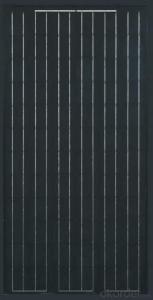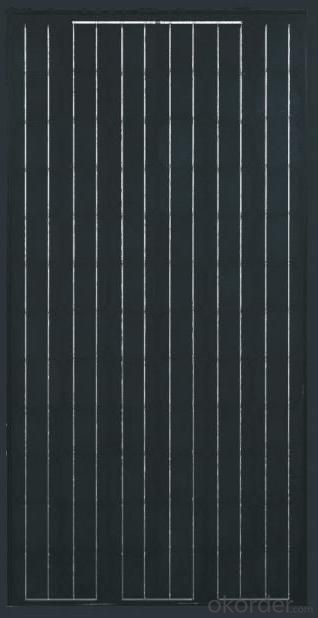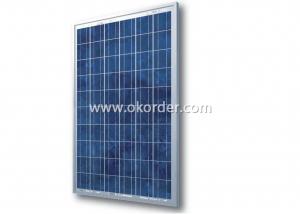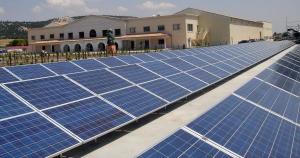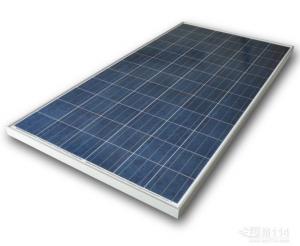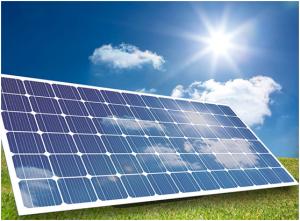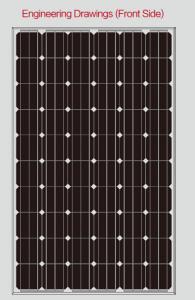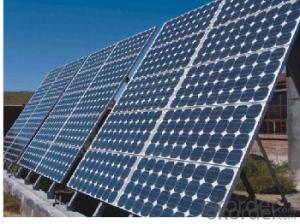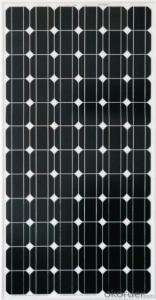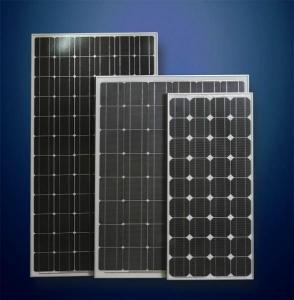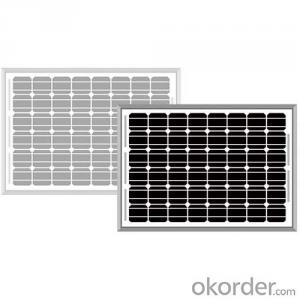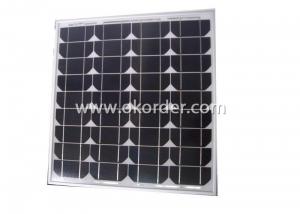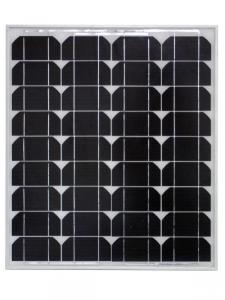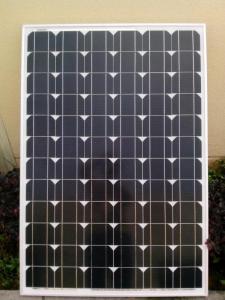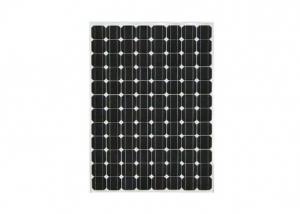Hyundai Solar Panels - Monocrystalline Solar Module 194w
- Loading Port:
- China Main Port
- Payment Terms:
- TT OR LC
- Min Order Qty:
- -
- Supply Capability:
- -
OKorder Service Pledge
OKorder Financial Service
You Might Also Like
Solar Monocrystalline (210W-225W)
Introduction of Solar Monocrystalline (210W-225W)
Solar modules use light energy (photons) from the sun to generate electricity through the photovoltaic effect. The majority of modules use wafer-based crystalline silicon cells or thin-film cells based on cadmium telluride or silicon. The structural (load carrying) member of a module can either be the top layer or the back layer. Cells must also be protected from mechanical damage and moisture. Most solar modules are rigid, but semi-flexible ones are available, based on thin-film cells. These early solar modules were first used in space in 1958.
CNBM Solar photovoltaic (PV) Panel is designed for large electrical power requirements. It is the optimal choice for both on-grid and off-grid power systems. CNBM Solar panel offers high performance of power per square foot of solar array. Monocrystalline silicon(c-Si): often made using the Czochralski process. Single-crystal wafer cells tend to be expensive, and because they are cut from cylindrical ingots, do not completely cover a square solar cell module without a substantial waste of refined silicon. Hence most c-Si panels have uncovered gaps at the four corners of the cells.
Characteristics of Solar Monocrystalline (210W-225W)
I. Solar Cell : High efficiency crystalline solar cell. Even if under the weak light, the solar module can produce maximum power output.
II. Tempered glass (toughened glass): Anti-reflecting coating and high transmission rate glass increase the power output and mechanical strength of solar module.
III. EVA and TPT: Using high quality EVA and TPT to prevent destroying and water.
IV. AI frame: Without screw, corner connection. 6 holes on the frame can be installed easily.
V. Junction box: Multi function junction box with water proof.
VI. Long lifetime: ≥25 years; Less power decrease.
VII. Good performance of preventing from atrocious weather such as wind and hails.
VIII. Resisting moisture and etching effectively, not effected by geology.
IX. The certificate issued by international authority: UL, TUV, IEC, VDE, CE.
Standard Test Conditions of Solar Monocrystalline (210W-225W)
The opto-electrical specifications shown below are stabilized values being measured at Standard Test Conditions, Irradiance: 1000W/m2, Spectrum: AM1.5 at 25°C, The info below is subject to manufacturing tolerances. Where appropriate minutes of measurement are available and are used for the dimensioning of the installation.
Advantages of Solar Monocrystalline (210W-225W)
• CNBM Solar performance guarantees for 25 years
• 10 years guarantee for workmanship
• Timeliness of delivery
• Quality Products certified (TÜV, UL, CE, VDE, ISO)
CNBM International Corporation's products including Monocrystalline Solar Panel, Polycrystalline Solar Panel have received and enjoyed famous reputation in many countries and regions in the world .As a solar panel manufacturer in China, we strive to provide our customers with excellent service, superior products and unmatched value.
- Q: Can solar panels be installed on theme parks or entertainment venues?
- Yes, solar panels can be installed on theme parks or entertainment venues. In fact, many theme parks and entertainment venues around the world have already embraced solar energy as a sustainable and cost-effective solution. By installing solar panels, these venues can generate their own clean energy, reduce their carbon footprint, and save on energy costs in the long run.
- Q: is this fact true? - its a limitation to solar panels during summer when it's in extremly hot countrie. I've heard it from my science teacher .. please give detail if you have any and any more benefits/limitations is welcomed .. Thank you :) !
- Solar okorder /... you'll notice that they have different curves for different temperatures. But they do still produce power, certainly. I have an array on my roof, and it still manages to max out the inverter on a hot summer day. But I do notice that the top row, which is hotter due to heat rising from those below, consistently puts out a few less watts than the bottom row. So more sun is certainly better; direct light is exactly what's needed. But hot panels due to poor air circulation or high ambient temperature does cut into efficiency. (Solar thermal, of course, is a different story)
- Q: I have an electric bicycle that I travel to work by, pulling a modified child carrying trailer that holds two 2 volt deep cycle batteries in series to power the 24 volt bike motor. I'm thinking about adding a 50 watt solar panel (or larger depending on the room I can make available) to charge while I'm at work and to provide some extra juice while on my more distant travels.Can I get a solar panel to charge them while they're connected the way they are: in series? Does charging work that way?I've read that in order to charge the 24 volt battery setup (if the answer to the Q above is yes), the output from my solar panel would need to be a little more than 24 volts. Is this true? If so, how many volts?Since the bike is supposed to be powered at 24 volts and I have an x-volt (x gt; 24v) solar panel connected to it, will this cause any damage to the controller or other components while running them?Will it help supply power even while the motor is being run?Thanks.
- You did not give the AH rate from your 24V battery pack,therefore , unable to suggest a correct current rate solar panel. The solar panel open voltage rate at least 30V to charge a 24V cell. No harm to controller since the charging current is so small even bike is in running condition.
- Q: Can solar panels be used for powering outdoor events or festivals?
- Yes, solar panels can be used to power outdoor events or festivals. They are a sustainable and renewable energy source that can provide electricity for various needs such as lighting, sound systems, food stalls, and more. Solar panels can be set up in strategic locations to capture sunlight and convert it into usable energy, reducing the reliance on fossil fuels and minimizing the environmental impact of such events.
- Q: How much sunlight is needed for solar panels to work?
- Solar panels can work with any amount of sunlight, but they are most efficient when exposed to direct sunlight for at least 5-6 hours per day.
- Q: If my school was to purchase enough solar panels to run the school off only their power, how much might that cost? (I have a really small school, only 384 kids.)Just general prices of solar panels and how much electricity they yield would be fine too.
- Solar panels typically cost in the range of 8 to 0 dollars per kilowatt of power they are capable of providing. That same kilowatt of power costs in the range of 8 to 0 cents normally. This is the reason solar is not all that viable, without government incentives. The person who responded You're looking at $0,000 to $40,000... is so far off the real answer as to not even be funny. I suspect a solar pv system for a school would start in the $400,000 to $500,000 range. Many areas though have incentives, which will reduce the actual out of pocket costs (but not to $0k).
- Q: Can we cover up solar panels on our house with regular siding?
- Finding okorder /
- Q: Can solar panels be used for charging electric vehicles?
- Yes, solar panels can be used to charge electric vehicles.
- Q: I live in the UK, I have no savings (so would have to take out a loan of about ?8000), I don't know how long I plan to stay in my house, I might want to move in a year or two to take advantage of a better job so I want to keep the option open of being able to sell my house without having to pay off the cost of having the panels fitted (which I probably won't get back on the increased value they add to my house).What are the main advantages of having solar panels?What are the pitfalls the ever so eager cold callers with quotas to fill don't tell you about?Basically is it worth having them?Thankyou.
- Homemade okorder /
- Q: Can solar panels be used to power a water pump?
- Yes, solar panels can be used to power a water pump. Solar panels convert sunlight into electricity, which can then be used to power a water pump. This allows for a sustainable and renewable energy source to operate the pump without relying on conventional electricity grids or fossil fuels.
Send your message to us
Hyundai Solar Panels - Monocrystalline Solar Module 194w
- Loading Port:
- China Main Port
- Payment Terms:
- TT OR LC
- Min Order Qty:
- -
- Supply Capability:
- -
OKorder Service Pledge
OKorder Financial Service
Similar products
Hot products
Hot Searches
Related keywords
